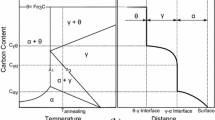Conclusions
-
1.
The carbide phase in complex-alloy die steel 8Kh4V2S2MF is appreciably broken up on increasing the temperature of electric heating for quenching from 1000 to 1200°C (a heating rate of 20 deg/sec in the region of the phase transformations).
-
2.
Electrothermal treatment ensures a finer carbide phase than heat treatment in accordance with the optimal regime with heating in a salt melt.
Similar content being viewed by others
Literature cited
A. S. Kholin et al., “Electrothermal treatment of high-alloy die steels,” Metalloved. Term. Obrab. Met., No. 11, 54 (1978).
S. A. Saltykov, Stereometric Metallography [in Russian], Metallurgiya, Moscow (1970).
Additional information
Translated from Metallovedenie i Termicheskaya Obrabotka Metallov, No. 11, pp. 38–40, November, 1982.
Rights and permissions
About this article
Cite this article
Kholin, A.S., Chekhovoi, A.N., Abramov, A.I. et al. Effect of electrothermal treatment on the carbide phase in die steel 8Kh4V2S2MF. Met Sci Heat Treat 24, 798–800 (1982). https://doi.org/10.1007/BF00774738
Issue Date:
DOI: https://doi.org/10.1007/BF00774738




